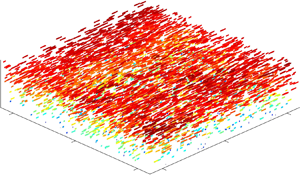Crossref Citations
This article has been cited by the following publications. This list is generated based on data provided by
Crossref.
Zhang, Yifan
Li, Jinshi
Kang, Jianhong
and
Zhou, Fubao
2021.
Experimental study on the flow and heat transfer behavior of polymer solutions in the closed liquid ring vacuum pump system.
Applied Thermal Engineering,
Vol. 199,
Issue. ,
p.
117525.
Tian, Guizhong
Zhang, Yaosheng
Feng, Xiaoming
and
Hu, Yushen
2022.
Focus on Bioinspired Textured Surfaces toward Fluid Drag Reduction: Recent Progresses and Challenges.
Advanced Engineering Materials,
Vol. 24,
Issue. 1,
Mitishita, Rodrigo S.
Elfring, Gwynn J.
and
Frigaard, Ian. A.
2022.
Turbulent drag reduction of viscoelastic wormlike micellar gels.
Journal of Non-Newtonian Fluid Mechanics,
Vol. 301,
Issue. ,
p.
104724.
Warwaruk, Lucas
and
Ghaemi, Sina
2022.
Near-wall lubricating layer in drag-reduced flows of rigid polymers.
Physical Review Fluids,
Vol. 7,
Issue. 6,
Cheng, Shyuan
Kaufman, Shaelynn
Tipnis, Vaibhav
Best, James L.
and
Chamorro, Leonardo P.
2022.
Effects of low clay concentrations on nearly isotropic turbulence.
Physical Review Fluids,
Vol. 7,
Issue. 7,
Lin, Che-Yu
Owolabi, Bayode E.
and
Lin, Chao-An
2022.
Polymer-turbulence interactions in a complex flow and implications for the drag reduction phenomenon.
Physics of Fluids,
Vol. 34,
Issue. 4,
Serafini, F.
Battista, F.
Gualtieri, P.
and
Casciola, C. M.
2022.
Drag Reduction in Turbulent Wall-Bounded Flows of Realistic Polymer Solutions.
Physical Review Letters,
Vol. 129,
Issue. 10,
Azadi, Reza
and
Nobes, David S.
2022.
Hydrodynamic cavitation reduction in semidilute turbulent polymer solution flows.
Journal of Fluid Mechanics,
Vol. 952,
Issue. ,
Warwaruk, Lucas
and
Ghaemi, Sina
2023.
Polymer and surfactant flows through a periodically constricted tube.
Journal of Fluid Mechanics,
Vol. 960,
Issue. ,
Mitishita, Rodrigo S.
Elfring, Gwynn J.
and
Frigaard, Ian. A.
2023.
Statistics and spectral analysis of turbulent duct flows with flexible and rigid polymer solutions.
Journal of Non-Newtonian Fluid Mechanics,
Vol. 311,
Issue. ,
p.
104952.
Koide, Yusuke
and
Goto, Susumu
2023.
Effect of scission on alignment of nonionic surfactant micelles under shear flow.
Soft Matter,
Vol. 19,
Issue. 23,
p.
4323.
Niu, Jintao
Wang, Jiansheng
Liu, Xueling
and
Dong, Liwei
2024.
An active control strategy for simultaneously achieving turbulent drag reduction and heat transfer enhancement in heat exchangers: Oscillation of micro cuboid vortex generators.
International Communications in Heat and Mass Transfer,
Vol. 159,
Issue. ,
p.
108315.
Warwaruk, Lucas
and
Ghaemi, Sina
2024.
Local flow topology of a polymer-laden turbulent boundary layer.
Journal of Fluid Mechanics,
Vol. 983,
Issue. ,
Luo, Zhengjie
Jia, Xuguang
Zhu, Shining
Zhao, Pengfei
Zhang, Kaisheng
and
Guo, Hao
2024.
A bio-inspired two-stage bionic drag reduction method.
Review of Scientific Instruments,
Vol. 95,
Issue. 3,
Meng, Junqing
Wang, Jie
Wang, Lijuan
Lyu, Chunhui
Lyu, Yingpei
and
Nie, Baisheng
2024.
Effects of polymer-surfactant interactions on drag reduction performance and mechanisms: Molecular dynamics simulations and experimentation.
Colloids and Surfaces A: Physicochemical and Engineering Aspects,
Vol. 684,
Issue. ,
p.
133126.
Li, Shang
Xin, Meiling
Su, Xuan
Ding, Chaogang
Liu, Xiufang
Zhang, Donghe
He, Zhongyuan
Li, Zhenyu
Xu, Jie
and
Guo, Bin
2025.
Multi-factors bionic lubricant-infused PDMS micropores surface for drag reduction application: design, construction and property.
Surfaces and Interfaces,
Vol. 72,
Issue. ,
p.
107003.
Kozhus, Olga
Barsukov, Gennady
Zhuravleva, Tatyana
Petrukhin, Anton
and
Prasolov, Egor
2025.
Increasing the productivity of waterjet cutting technology by introducing surface-active additives.
Vol. 3347,
Issue. ,
p.
020043.
Chen, Yang
Niu, Pengyuan
He, Minglan
Li, Changjun
Nechval, Andrey M.
Valeev, Anvar R.
and
Yang, Peng
2025.
Turbulent drag reduction behavior of polymer solutions in different geometries.
Energy,
Vol. 323,
Issue. ,
p.
135798.



